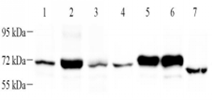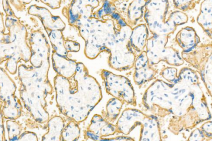Anti-Placental alkaline phosphatase (PLAP) Rabbit pAb (100 μl)
| Reactivity: | H,R & H |
| Applications: | WB & IHC |
| Host Species: | Rabbit |
| Clonality: | Polyclonal |
| Full Name: | Placental alkaline phosphatase (PLAP) rabbit polyclonal |
Gene Name: | Alkaline phosphatase, placental type |
Synonyms: | Alkaline phosphatase Regan isozyme, Placental alkaline phosphatase 1, PLAP-1, ALPP, PLAP |
Immunogen: | KLH conjugated Synthetic peptide corresponding to Human Placental alkaline phosphatase (PLAP) |
Isotype: | IgG |
Purity: | Affinity purification |
Subcellular location: | |
Predicted MW. | 58 kDa |
Observed MW. | 72 kDa |
Uniprot ID: |
Product Usage Information
Applications | Species | Dilution | Positive tissue |
WB | Human, Rat | 1: 500-1: 1000 | uterus |
IHC | Human | 1: 200-1: 400 | placenta |
Background
Placental alkaline phosphatase (PLAP) is a glycosyl phosphatidylinositol (GPI)-anchored sialoglycoprotein , which shows greater resistance to heat inactivation than other alkaline phosphatase. Presented at high levels in placental trophoblasts, PLAP is recognized as an important marker of differentiation in human malignancies.
Images
| Western blot analysis of PLAP (GB112545) at dilution of 1: 1000 Lane 1: HeLa cell lysate Lane 2: HaCaT cell lysate Lane 3: SiHa cell lysate Lane 4: SKBR3 cell lysate Lane 5: HepG2 cell lysate Lane 6: A431 cell lysate Lane 7: Mouse uterus tissue lysate |
| Immunohistochemistry analysis of paraffin-embedded human placenta using PLAP (GB112545) at dilution of 1: 400 |
Storage
| Storage | Store at -20°C for one year. Avoid repeated freeze/thaw cycles. |
| Storage Buffer | PBS with 0.02%sodium azide,100 μg/ml BSA and 50% glycerol. |





